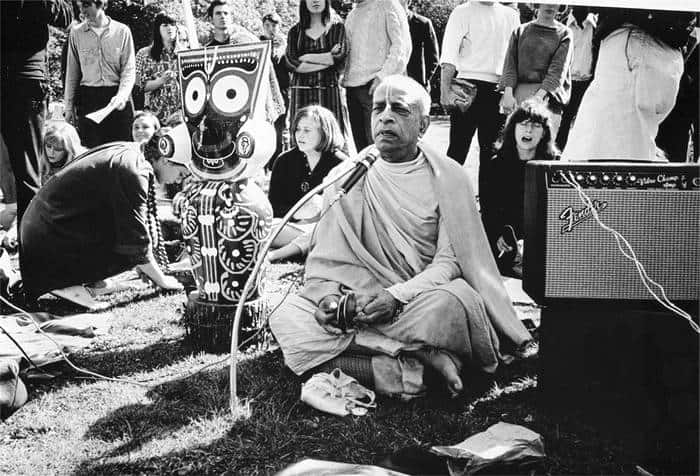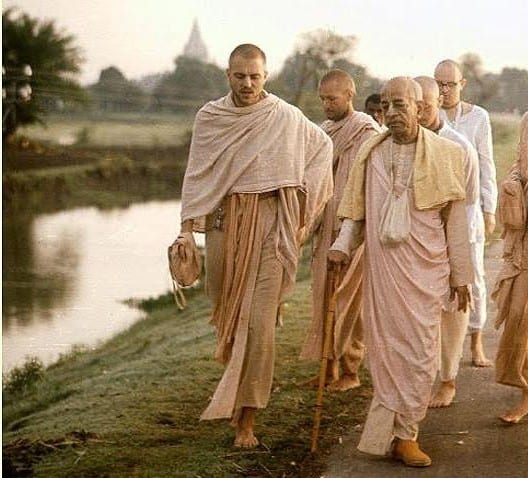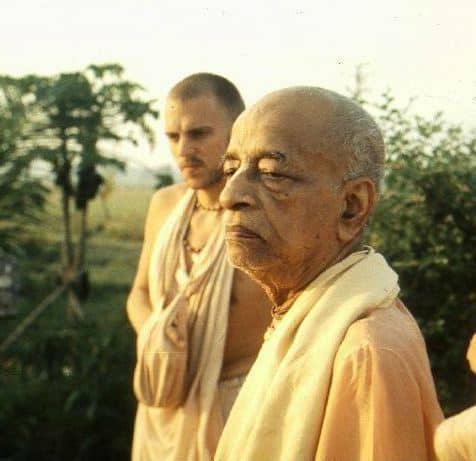His Divine Grace, A.C. Bhaktivedanta Swami Prabhupada (1896-1977) is widely regarded as the worlds pre-eminent exponent of the teachings and practices of bhakti-yoga to the Western world. He was a Gaudiya Vaishnava spiritual teacher (guru) and the founder of the International Society for Krsna Consciousness (ISKCON), commonly known as the “Hare Krsna Movement.” He taught that each soul is part and parcel of the quality of God and that one could find true happiness through living a simpler, more natural way of life and dedicating one’s energy in the service of God and all living beings.
Srila Bhaktivedanta Swami Prabhupada was born On September 1, 1896, in Calcutta and was raised in a family devoted to Lord Krsna. He was named Abhay Charan, which means “one who is fearless, having taken shelter at Lord Krsna’s feet.” He birthday coincided with Nandotsava, a festival given by Lord Krsna’s father the day after he was born.
As a young man, Abhay Charan became involved with Mahatma Gandhi’s civil disobedience movement. Yet, in 1922 when he was introduced to bhakti-yoga by his spiritual teacher, Srila Bhaktisiddhanta Saraswati Thakur, other interests faded. Srila Bhaktisiddhanta Saraswati Thakur was a prominent scholar and spiritual leader and Abhay was deeply moved by Srila Bhaktisiddhanta’s devotion and wisdom. He soon dedicated himself to spreading the teachings of Caitanya Mahaprabhu. After his initiation in 1933, Srila Bhaktisiddhanta requested him specifically to carry this tradition to the English-speaking world.
From 1950 onwards, he lived at the medieval Radha-Damodar mandir in the holy town of Vrindavan, where he began his commentary and translation work of the Sanskrit work Bhagavata Purana. This temple had a large collection of original writings of the Six Gosvamis and their followers. This was inspired again by his guru’s encouragement to him to print books.
After he finished the duties related to his wife, he took sannyasa, vows of renunciation. He was then known as Bhaktivedanta Swami. In 1965, he set off on his mission to preach in the West. He was elderly and had very little money when he boarded a cargo ship to New York. It was a long and difficult journey that took 35 days. He was 70 years old and he had 2 heart attacks along the way. When he reached the Brooklyn peer, he had only the equivalent of seven dollars. The only thing he carried with him was a crate of his translations of sacred Sanskrit texts.
The Jaladuta Diary was published from a journal kept by Prabhupada. Between 25 August 1965 and 30 August 1965, the Jaladuta Journal falls silent for six days. On the seventh day, 31 August, the silence is broken with these simple words, “Passed over a great crisis on the struggle for life and death.”
He wrote the following words shortly after he arrived in New York: “I do not know why You have brought me here. Now You can do whatever You like with me. But I guess You have some business here, otherwise, why would You bring me to this terrible place? How will I make them understand this message of Krsna consciousness? I am very unfortunate, unqualified and most fallen. Therefore I am seeking Your benediction so that I can convince them, for I am powerless to do so on my own.”
When he first reached New York, Swami Prabhupada remained in poverty and without a place to live. He began his mission by giving talks on the Bhagavad-gita in the Bowery (also called skid row, a very rough part of the city) and leading kirtan in Tompkins Square Park. His timing for landing in New York was optimal for reaching young people who were in the midst of promoting revolutions in consciousness. Hippies were rebelling against society, government, and the status quo. After many felt betrayed by the government sending so many of their friends and family members to fight and die in the Vietnam War, they sought alternatives to the average lifestyle and belief systems. Many were already interested in exploring eastern religious traditions, so Bhaktivedanta Swami’s message of peace and goodwill greatly appealed to them.
“Srila Prabhupada gave meaning to many whose lives had become meaningless during the countercultural revolution. In a time of prosperity, many American youths have felt a disdain for the materialistic goals of the established culture. They have not felt that earning more money to spend on sensual pleasures has given an abiding happiness to their parents. They have come to believe that there must be a more valuable transcendental reality which they have yet to find. Therefore, they have not found direction toward a goal in our established culture, nor have they found meaning in the mainline religions that have supported this culture. For these people, Srila Prabhupada has provided a meaningful place which bears witness to quite different objectives, and he has provided a strict discipline by means of which one may achieve them. “
– Dr. Stillson Judah, Professor of the History of Religions and Director of the Library, Graduate Theological Seminary, Berkeley, California
As the months went by, students who wished to dive deeper into the study and practice of bhakti-yoga came to him in increased numbers. They helped him rent a storefront on the Lower East Side that was converted to a temple. In July of 1966, Bhaktivedanta Swami established the International Society for Krsna Consciousness for the purpose of checking the imbalance of values in the world and working for real unity and peace. When it was suggested to him at the time of founding ISKCON that a broader term “God Consciousness” would be preferable to “Krsna Consciousness” in the title, he rejected this recommendation, suggesting that the name Krsna includes all other forms and concepts of God.
Having begun initiating his American followers into the Gaudiya Vaishnava lineage, Bhaktivedanta Swami next traveled to San Francisco. Amidst the emerging hippie community in the Haight-Ashbury district, during 1967’s “Summer of Love,” he taught that the experience of devotion through kirtan was a spiritual “high” superior to any pleasures derived from material sources such as wealth, fame, or intoxication. In the following months many more came forward to assist him. Desiring to address him with the respect due to a revered spiritual teacher, his disciples began to call him Srila Prabhupada, meaning “one at whose feet the masters sit.”
“By patience, good humor, and singing and chanting and expounding Sanskrit terminology, he day-by-day established Krsna consciousness in the psychedelic center of America East. He and his children sang the first summer through in Tompkins Square…To choose to attend to the Lower East Side, what kindness and humility and intelligence ….The main thing, above and beyond all our differences, was an aroma of sweetness that he had, a personal, selfless sweetness like total devotion. And that was what always conquered me.”
-Allen Ginsberg, a well- known poet of the “Beat Movement,” said,
George Harrison of the Beatles eventually became his disciple. He said, “The thing that always stays is his saying, “I am the servant of the servant of the servant.” I like that. A lot of people say, “I’m it. I’m the divine incarnation. I’m here and let me help you.” You know what I mean? But Prabhupada was never like that. I liked Prabhupada’s humbleness. I always liked his humility and his simplicity.”
Under his careful guidance, the Society has grown within a decade to a worldwide confederation of almost one hundred asramas, schools, temples, institutes and farm communities. In 1968, Srila Prabhupada created New Vrndavana, an experimental Vedic community in the hills of West Virginia. Inspired by the success of New Vrndavana, then a thriving farm community of more than one thousand acres, his students founded several similar communities in the United States and abroad.
In 1972, His Divine Grace introduced the Vedic system of primary and secondary education in the West by founding the Gurukula school in Dallas, Texas. The school began with three children in 1972, and by the beginning of 1975, the enrollment had grown to one hundred fifty.
Srila Prabhupada also inspired the construction of a large international center at Sridhama Mayapur in West Bengal, India, which is also the site for a planned Institute of Vedic Studies. A similar project is the magnificent Krsna-Balarama Temple and International Guest House in Vrndavana, India. These are centers where Westerners can live to gain firsthand experience of Vedic culture.
“Srila Prabhupada lived with the spirit of the Lord’s compassion shining through his heart. Through his example, he showed how to live as a true well-wisher and friend of every living being. The genuine essence of all spiritual teachings can be understood by observing his qualities, hearing his words and reading his books.”
– Radhanath Swami
In the last ten years of his life, in spite of his advanced age, Srila Prabhupada circled the globe twelve times on lecture tours that have taken him to six continents. In spite of such a vigorous schedule, Srila Prabhupada continued to write prolifically. His writings constitute a veritable library of Vedic philosophy, religion, literature, and culture.
Perhaps Srila Prabhupada’s most significant contribution is his books. He authored over seventy volumes on bhakti-yoga, which are highly respected for their authority, depth, clarity, and fidelity to tradition. His writings have been translated into seventy-six languages. His most prominent works include Bhagavad-gita As It Is, the thirty-volume Srimad-Bhagavatam, and the seventeen-volume Sri Caitanya-caritamrita.
Prominent scholars also were attracted to Srila Prabhupada. Although he received criticism from anti-cult groups, he received a favourable welcome from religious scholars such as J. Stillson, Judah, Larry Shinn, and Thomas Hopkins, who praised Bhaktivedanta Swami’s translations. Harvey Cox, Professor of Divinity at Harvard University said, “In my view, Srila Prabhupada’s contribution is a very important one and will be a lasting one….This life of Srila Prabhupada is pointed proof that one can be a transmitter of truth and still be a vital and singular person. “
For millennia the teachings of bhakti-yoga had been concealed within Sanskrit and Indian vernacular languages, and the rich culture of bhakti had been hidden behind the borders of India. Today, millions around the globe express their gratitude to Srila Prabhupada for revealing the timeless wisdom of bhakti to a world immersed in a materialistic and self-destructive ethos.
Making these Vaisnava texts available is one of Srila Prabhupada’s greatest contributions. Apart from the masses, his books have also reached well into academic circles and have spurred academic interest in the Caitanya tradition … The significance of making these texts available is not merely academic or cultural; it is spiritual.”
-Shrivatsa Goswami
A.C. Bhaktivedanta Swami Prabhupada passed away on November 14, 1977, in the holy town of Vrindaban, surrounded by his loving disciples who carry on his mission today. Through his mission and example, he introduced bhakti-yoga to an international audience. This was the fulfillment of his lifelong mission to introduce Caitanya Mahaprabhu’s teachings to the world.



